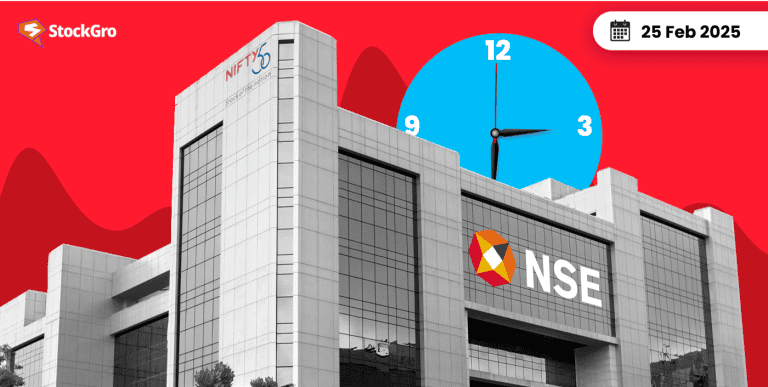
The Indian stock market has been on a rollercoaster ride, with the Sensex crashing over 800 points and Nifty slipping below 22,500 on February 24. This marks the fifth consecutive session of declines, leaving investors concerned about the reasons behind the selloff and what lies ahead.
From foreign portfolio investors (FPIs) pulling out billions to rising global tensions and weak economic indicators, several factors are at play. Let’s break down the key reasons behind this market dip and what it means for investors.
Market performance: A steep decline
On Monday, February 24, the Sensex opened at 74,893.45, significantly down from its previous close of 75,311.06. It further tumbled 924 points to hit 74,387.44 during the session. The Nifty 50 also saw a sharp fall, opening at 22,609.35 against its previous close of 22,795.90, eventually dropping to 22,518.80.
Key market stats:
| Index | Closing Value | Change |
| Sensex | 74,454.41 | -857 points (-1.14%) |
| Nifty 50 | 22,553.35 | -243 points (-1.06%) |
| BSE Midcap Index | -0.78% | |
| BSE Smallcap Index | -1.31% |
The overall market capitalisation of BSE-listed firms dropped to ₹398 lakh crore from about ₹402 lakh crore, wiping out nearly ₹4 lakh crore in investor wealth in a single session.
Also read: Aarvee Denims Soars 533% in 9 Months Despite Market Weakness
5 key reasons behind the Indian stock market selloff
1. Fears of a global trade war
The spectre of a full-blown trade war between the US and other economies is once again haunting global markets. US President Donald Trump’s recent tariff hikes on key imports, including automobiles, semiconductors, pharmaceuticals, and metals, have sparked concerns about slower global growth.
With countries retaliating, investors fear a disruption in trade flows and a potential economic slowdown, leading to caution in emerging markets like India.
2. Heavy foreign investor sell-off
Foreign portfolio investors (FPIs) have been offloading Indian equities at an alarming rate due to rising US bond yields and high market valuations.
- FPIs sold ₹37,000 crore worth of Indian equities in February alone (until the 21st).
- Since October 2024, FPIs have withdrawn a massive ₹3 lakh crore from Indian markets.
The uncertainty around US interest rate policies and inflation trends is driving foreign capital away from emerging markets, contributing to the market downturn.
3. The China effect: Money flowing out of India
The Chinese stock market has been on an upward trend, attracting investors who see better value in Chinese stocks compared to India’s still stretched valuations.
With the Chinese government implementing supportive policies to boost market sentiment, some investors have shifted their portfolios from Indian equities to Chinese markets, adding to India’s market pressure.
4. Macroeconomic concerns
While India’s economy has been a bright spot in recent years, new data suggests that a slowdown may be around the corner:
- Moody’s Analytics predicts that India’s GDP growth will slow to 6.4% in 2025 from 6.6% in 2024.
- Global demand is softening, impacting India’s export sector.
- Domestic inflation remains a concern, affecting consumer spending and corporate profits.
The market had rallied on expectations of strong economic growth, but with these signs of cooling off, investors are now recalibrating their expectations.
5. Uncertainty over US Federal Reserve’s rate policy
Hopes of a US Fed rate cut are fading, leading to more caution among global investors. Recent US inflation data suggests that the Federal Reserve may hold rates higher for longer, dampening global risk appetite.
- The US Consumer Price Index (CPI) rose 0.5% in January.
- The S&P Global US Composite PMI fell to 50.4, the lowest since September 2023, signalling economic weakness.
- The US bond yields remain elevated, making safer assets more attractive than emerging market equities like India.
Experts warn that if US interest rates remain high, capital outflows from India could continue, adding to market volatility.
Sectoral impact: Who lost the most?
While the market selloff was broad-based, some sectors suffered more than others.
Biggest Losers
| Sector | Drop (%) |
| Nifty IT | -2.71% |
| Nifty Metal | -2.17% |
| Oil & Gas | -1.10% |
| Nifty Bank | -0.67% |
Who managed to stay afloat?
| Sector | Change (%) |
| Nifty FMCG | +0.36% |
| Auto | +0.22% |
| Pharma | +0.02% |
What should investors do now?
With the market in correction mode, it’s crucial to focus on long-term strategies rather than panic selling.
- Stick to fundamentally strong stocks: Companies with solid balance sheets and strong earnings potential will likely recover faster.
- Diversify portfolios: A mix of equities, bonds, and gold can help hedge against volatility.
- Avoid impulsive trading: Market downturns often present buying opportunities in quality stocks at discounted prices.
Investors should stay cautious but not completely step away from the market. With macroeconomic concerns and global uncertainties persisting, short-term volatility is expected, but long-term prospects for Indian equities remain strong.
You may also like: M&M Share Price Declines 6% Amid Rights Issue Investment Plans
Conclusion
The sharp decline in Sensex and Nifty is being driven by multiple factors, from global trade tensions and FPI outflows to economic slowdown fears. While short-term challenges persist, long-term investors should use this phase to reassess their portfolio and take advantage of lower valuations.
With more clarity expected on US Fed policies and global growth trends in the coming months, the key is to stay informed and make calculated investment decisions.

